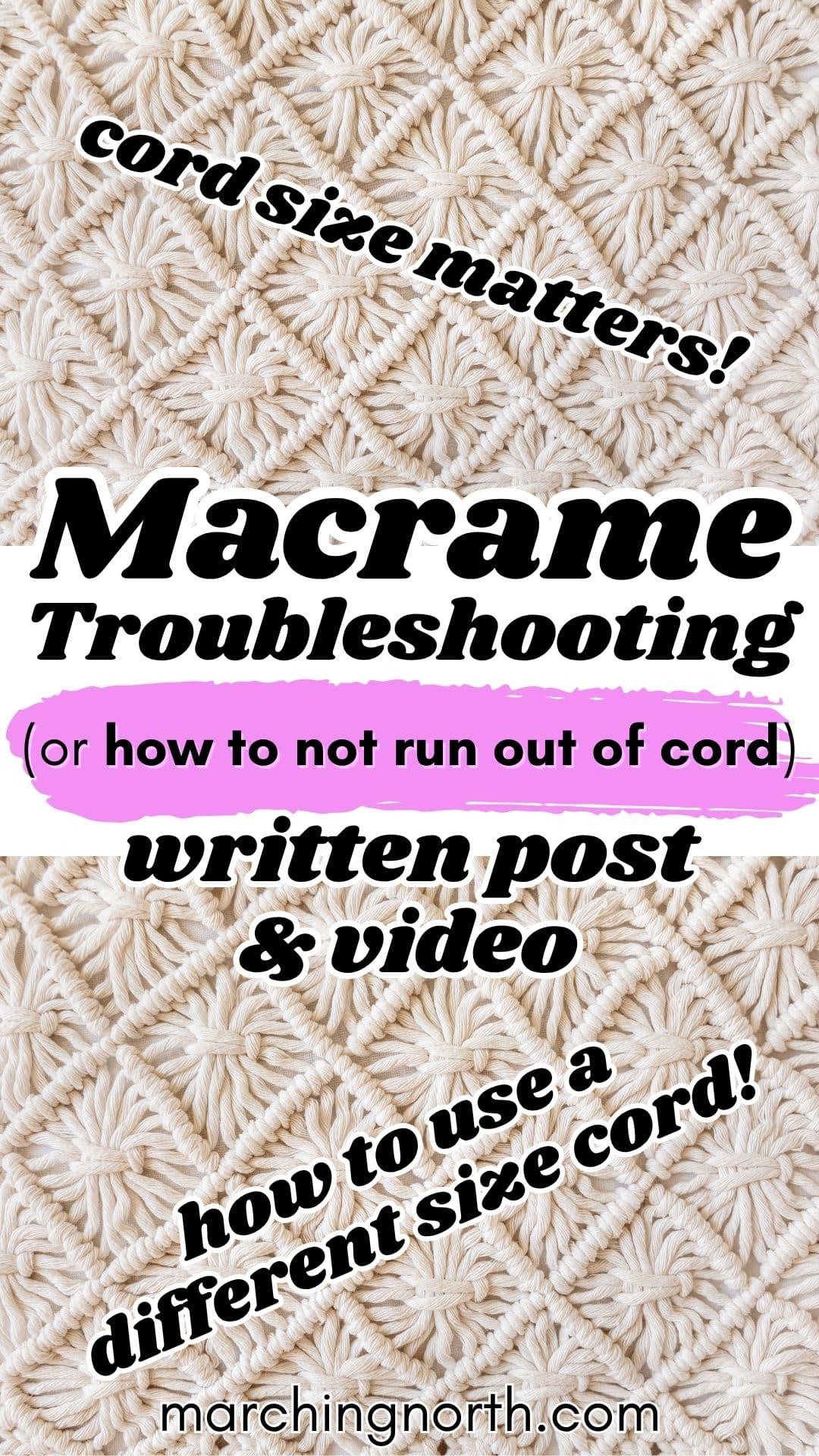Macrame Troubleshooting (No More Running Out of Cord!)
Have you ever looked at a macrame pattern and thought, “Hmm… it says 4 mm cord, but I only have 5 mm… is that good enough?”
Or, have you been happily working away on a macrame pattern, only to get halfway through and run out of cord? (Grrr!!)
Those two things are the most common questions and issues I see, and today we’re going to clear up the confusion once and for all.
Cord size absolutely does matter, but don’t worry.
In this blog post (and video), I’m going to walk you through exactly what happens when you use a different size cord, how to adjust your lengths, and a few other tips that’ll save you time, frustration, and, well… cord.
So let’s dive right in!
Don’t forget to pin this for later!

(This post may contain affiliate links. If you click one and make a purchase, I may receive a small commission at no extra cost to you. Read the disclaimer here. Thank you for your support!)
Check out the Video!
The video that goes along with this post is over on my YouTube channel. Be sure to like and subscribe, it really helps me out with ye olde algorithm!
Cord Size MATTERS
One of the most common questions I get asked goes something along the lines of…
“Your pattern calls for 4 mm cord, but I only have 5 mm cord. Will that work?”
Or sometimes it’ll go the other way, like…
“Your pattern calls for 4 mm cord, but I only have 3 mm cord, that’s basically the same, right??”
And the answer is…. no, it’s not the same and it won’t work. Lol.
I mean, it could work, you’ll just need to make some adjustments to the pattern.
Here are the main rules to remember: If you use a larger size cord than the pattern calls for, you need to cut the cords longer, or you’ll end up running out of cord before you finish the project.
And the larger the cord is, the longer the starting cords need to be.
So, if you used 5 mm cord when it called for 3 mm cord, you have to make them even longer.
On the other hand, if you use a smaller size cord than the pattern calls for, you’ll need to cut the cords shorter, or you’ll end up with a lot of waste cord at the end.
There is a little bit of math involved in figuring out approximately how much longer or shorter you need to make the cords. (Eeek.)
But basically, you just do what it says in this chart below. (Easier method incoming, just keep scrolling.)

So, for example, if you want to use 4 mm cord instead of 3 mm, you find 4 mm on the left side, and 3 mm at the top, find the point where they meet (kind of like a multiplication chart), and that will tell you what you need to do.
In that case, you would need to increase the cord lengths by 33%.
If you would like a 1000% simpler method to figure this out, I created an automatic calculator in Google Sheets that does the math totally for you, while you just sit back and relax.

The Macrame Cord Size Calculator is a total game changer. I use it all the time!
How to Measure Your Cord Size
Sometimes you’ll buy cord and it’ll say it’s one size, but really it’s another.
I’m not sure why this happens so often, but I’ve definitely seen people have issues with this one.
If you’re using what *claims* to be the right size cord, but you’re still running out, there’s a good chance the cord is actually thicker than it says.
To measure your cord, you’ll need a millimeter measuring device, and you just use it to measure across the width of the cord. However many millimeters it is across is the cord size.

It can be a little tricky to tell, but do your best. Whatever it’s closest to just go with that and you should be good.
Once you have that figured out, put a little label on the cord, or just write the size on the inside of the spool with a sharpie right near the edge. That way you won’t have to re-figure it out later.
One more important thing to note: you want to make sure you’re measuring the cord UNROLLED and not when it’s still tightly wrapped around the spool.
The cord will look thinner when it’s wrapped because that stretches it out a bit.
When you unroll it, the cord will naturally loosen up and be it’s true thickness, much like me around the holidays.
*ba dum, ching!*
But seriously, just unroll a foot or so of cord and measure that part, okay?
Cord Type Matters
Another issue that comes up sometimes is when you switch one type of cord for another.
Example: let’s say I have a pattern that calls for 4 mm single strand cotton string, and you have 4 mm twisted 3 ply rope on hand that you want to use instead.
Rope is usually much firmer than string, and when you tie a knot with it, you end up using more cord because it doesn’t tighten up as much.
But the single strand string, being much softer, would tighten up much more on the same knot and end up using less string.
So if you swap them out without taking that into account, you could end up running out of cord before the end of your project.

Braided cord is another popular type of cord, although I don’t use it a whole lot. But it’s similar to single strand string because it’s softer and it’s also stretchy.
If you tried to use 3 ply rope on a pattern that called for braided cord, it probably wouldn’t end well.
Generally, the results are unpredictable when you swap out a different type of cord for the one listed in the pattern willy-nilly.
Can you do it? Sure!
Should you? That’s for you to decide.
My advice: if you’re new, just stick to what the pattern calls for. It’ll make it a lot smoother for you.
But if you do decide to swap rope for string, make the cords longer.
And there really isn’t a *good way* to estimate how much longer, but I’d probably recommend that you overestimate, because that’s how I roll.
Other Factors
Those first 2 issues are the main big things that cause people headaches during macrame projects, at least as far as I’ve seen.
But I wanted to mention a couple of other things that can sometimes cause issues, too.
Although these aren’t as big of a deal.
Knot Tension
This is referring to how tight you make your knots.
If you tie them super tight, it would use less cord, if you make them pretty loose, it would use more cord.
This isn’t really a big issue as far as I can tell.
I recommend making your knots snug, but not like crazy tight for a few reasons:
- it’s easier to go back and untie them if you mess up
- your finished piece will look better
- your hands won’t hurt
And theoretically, if you did insist on tying your knots crazy tight, it could result in using less cord and having more waste at the end.
Or if you kept them all loosey-goosey, you might run out of cord prematurely.
But I’ve never seen anyone keep their knots that loose. So this is probably a non issue. I just wanted to throw it out there.
Spacing
This is referring to the amount of space you leave between rows of knots.
For example, if a pattern says to leave 5 inches of space before you tie the next row of knots, and you leave only 3 inches, it’ll affect the outcome. (I know, duh.)
The same goes for centimeters, or any unit of measure.
I always default to inches because I’m American and we use inches for some reason.
Again, not usually an issue because it’s pretty easy to measure and keep your spacing good, but it’s something to keep in mind.
Hey, did you run out of cord anyway, even after doing all this stuff?
Sometimes, despite our best efforts, things just don’t go according to plan.
Here’s a post all about how to add on more cord if you DO run out of cord mid project. It’ll be OK.
In Conclusion
I hope this post has been helpful for you, and your macrame woes will be over for good!
If you have any questions or comments, post them down below.
And if you want to get started on your next macrame project, check out my latest posts!
